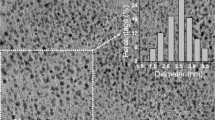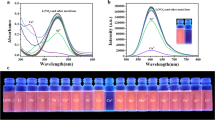Abstract
Here, one kind of hydrophilic hydroxypropyl β-cyclodextrin cross-linked polymer (HP-CDP) was prepared and used to establish a “turn-on” fluorescent probe for selective determination of captopril in biological samples. The HP-CDP has been synthesized in one step by cross-linking (2-hydroxypropyl)-β-cyclodextrin (HP-β-CD) with a rigid aromatic group linker tetrafluoroterephthalonitrile (TFT), and the synthesis parameters of HP-CDP were optimized with water solubility, yield, and adsorption capacity as indicators. When it was used as a luminescent material, we have found an interesting phenomenon that the fluorescence emission of HP-CDP was quenched after forming a coordination compound with ferric ions, and then recovered after adding a certain concentration of captopril, since captopril can reduce the ferric iron to ferrous ions and cause ligand replacement. Based on this observation, a novel turn-on fluorescent method was developed for the determination of captopril. The method exhibited good linearity in the range of 9.2 × 10−7 to 4.6 × 10−4 M (R2 = 0.9982) and a low detection limit of 1.8 × 10−7 M at optimum HP-CDP concentration, ferric ion concentration, pH, and incubation time. Moreover, interference experiments demonstrated that this fluorescence sensor had excellent selectivity that can commendably resist the interference from potential foreign substances. The proposed method has been successfully applied to determine captopril in human urine samples and may provide outstanding application potential in the future development of sensors. In addition, it is believed that HP-CDP also has a wide range of applications, for example, as a solubilizer, pollutant adsorbent, or drug carrier.

ᅟ








Similar content being viewed by others
References
McMurray J, Solomon S, Pieper K, Reed S, Rouleau J, Velazquez E, et al. The effect of valsartan, captopril, or both on atherosclerotic events after acute myocardial infarction: an analysis of the valsartan in acute myocardial infarction trial (VALIANT). J Am Coll Cardiol. 2006;47(4):726–33.
Huo S, Dong J, Song C, Xu J, Shen S, Ren Y, et al. Characterization of the reaction products, kinetics and mechanism of oxidation of the drug captopril by platinum(iv) complexes. RSC Adv. 2014;4(15):7402–9.
Sharpe DN, Douglas JE, Coxon RJ, Long B. Low-dose captopril in chronic heart failure: acute haemodynamic effects and long-term treatment. Lancet. 1980;2(8205):1154–7.
Luczak A, Zakrzewski R, Dobrogowski M. RP-HPLC-UV method coupled with post-column iodine-azide reaction for determination of free captopril in urine samples. Bioanalysis. 2012;4(12):1481–9.
Perez-Ruiz T, Martinez-Lozano C, Galera R. Development and validation of a capillary electrophoresis method with laser-induced fluorescence detection for the determination of captopril in human urine and pharmaceutical preparations. Electrophoresis. 2006;27(12):2310–6.
Pasquini B, Orlandini S, Caprini C, Del Bubba M, Innocenti M, Brusotti G, et al. Cyclodextrin- and solvent-modified micellar electrokinetic chromatography for the determination of captopril, hydrochlorothiazide and their impurities: a quality by design approach. Talanta. 2016;160:332–9.
Mazurek S, Szostak R. Quantitative determination of captopril and prednisolone in tablets by FT-Raman spectroscopy. J Pharm Biomed Anal. 2006;40(5):1225–30.
Fu Z, Huang W, Li G, Hu Y. A chemiluminescence reagent free method for the determination of captopril in medicine and urine samples by using trivalent silver. J Pharm Anal. 2017;7(4):252–7.
Tzanavaras PD, Themelis DG, Economou A, Theodoridis G. Flow and sequential injection manifolds for the spectrophotometric determination of captopril based on its oxidation by Fe(III). Microchim Acta. 2003;142(1–2):55–62.
Absalan G, Akhond M, Karimi R, Ramezani AM. Simultaneous determination of captopril and hydrochlorothiazide by using a carbon ionic liquid electrode modified with copper hydroxide nanoparticles. Microchim Acta. 2018;185(2):97–104.
Chen WT, Chiang CK, Lin YW, Chang HT. Quantification of captopril in urine through surface-assisted laser desorption/ionization mass spectrometry using 4-mercaptobenzoic acid-capped gold nanoparticles as an internal standard. J Am Soc Mass Spectrom. 2010;21(5):864–7.
Karimi A, Alizadeh N. Rapid analysis of captopril in human plasma and pharmaceutical preparations by headspace solid phase microextraction based on polypyrrole film coupled to ion mobility spectrometry. Talanta. 2009;79(2):479–85.
Sun Y, Zhang Z, Zhang X. Determination of captopril by high-performance liquid chromatography with direct electrogenerated chemiluminescence. Spectrochim Acta A Mol Biomol Spectrosc. 2013;105:171–5.
Mladic M, de Waal T, Burggraaff L, Slagboom J, Somsen GW, Niessen WMA, et al. Rapid screening and identification of ACE inhibitors in snake venoms using at-line nanofractionation LC-MS. Anal Bioanal Chem. 2017;409(25):5987–97.
Liu J, Liu G, Zang L, Liu W. Calcein-functionalized Fe3O4@SiO2 nanoparticles as a reusable fluorescent nanoprobe for copper(II) ion. Microchim Acta. 2014;182(3–4):547–55.
Hormozi-Nezhad MR, Bagheri H, Bohloul A, Taheri N, Robatjazi H. Highly sensitive turn-on fluorescent detection of captopril based on energy transfer between fluorescein isothiocyanate and gold nanoparticles. J Lumin. 2013;134(3):874–9.
Zhang S, Sun M, Yan Y, Yu H, Yu T, Jiang H, et al. A turn-on fluorescence probe for the selective and sensitive detection of fluoride ions. Anal Bioanal Chem. 2017;409(8):2075–81.
Yu L, Li Y, Yu H, Zhang K, Wang X, Chen X, et al. A fluorescence probe for highly selective and sensitive detection of gaseous ozone based on excited-state intramolecular proton transfer mechanism. Sensors Actuators B Chem. 2018;266:717–23.
Liu S, Yang M, Liu Y, Chen H, Li H. A novel “turn-on” fluorescent probe based on triphenylimidazole-hemicyanine dyad for colorimetric detection of CN(-) in 100% aqueous solution. J Hazard Mater. 2018;344:875–82.
Crini G. Review: a history of cyclodextrins. Chem Rev. 2014;114(21):10940–75.
Loftsson T, Brewster ME. Pharmaceutical applications of cyclodextrins: basic science and product development. J Pharm Pharmacol. 2010;62(11):1607–21.
Ikeda Y, Motoune S, Matsuoka T, Arima H, Hirayama F, Uekama K. Inclusion complex formation of captopril with alpha- and beta-cyclodextrins in aqueous solution: NMR spectroscopic and molecular dynamic studies. J Pharm Sci. 2002;91(11):2390–8.
Liang GD, Ren F, Gao HY, Wu Q, Zhu FM, Tang BZ. Bioinspired fluorescent nanosheets for rapid and sensitive detection of organic pollutants in water. ACS Sens. 2016;1(10):1272–8.
Zhao Y, Huang Y, Zhu H, Zhu Q, Xia Y. Three-in-one: sensing, self-assembly, and cascade catalysis of cyclodextrin modified gold nanoparticles. J Am Chem Soc. 2016;138(51):16645–54.
Yan Y, Zhang K, Yu H, Zhu H, Sun M, Hayat T, et al. Sensitive detection of sulfide based on the self-assembly of fluorescent silver nanoclusters on the surface of silica nanospheres. Talanta. 2017;174:387–93.
Yu H, Du L, Guan L, Zhang K, Li Y, Zhu H, et al. A ratiometric fluorescent probe based on the pi-stacked graphene oxide and cyanine dye for sensitive detection of bisulfite. Sensors Actuators B Chem. 2017;247:823–9.
Jay D, Cuellar A, Jay EG, Garcia C, Gleason R, Munoz E. Study of a Fenton type reaction: effect of captopril and chelating reagents. Arch Biochem Biophys. 1992;298(2):740–6.
Misik V, Mak IT, Stafford RE, Weglicki WB. Reactions of captopril and epicaptopril with transition metal ions and hydroxyl radicals: an EPR spectroscopy study. Free Radic Biol Med. 1993;15(6):611–9.
Alsbaiee A, Smith BJ, Xiao L, Ling Y, Helbling DE, Dichtel WR. Rapid removal of organic micropollutants from water by a porous beta-cyclodextrin polymer. Nature. 2016;529(7585):190–4.
Liu X, Na W, Liu H, Su X. Fluorescence turn-off-on probe based on polypyrrole/graphene quantum composites for selective and sensitive detection of paracetamol and ascorbic acid. Biosens Bioelectron. 2017;98:222–6.
Ma Q, Song JP, Zhang SF, Wang MF, Guo Y, Dong C. Colorimetric detection of riboflavin by silver nanoparticles capped with beta-cyclodextrin-grafted citrate. Colloids Surf B Biointerfaces. 2016;148:66–72.
Simoes SM, Veiga F, Ribeiro AC, Figueiras AR, Taboada P, Concheiro A, et al. Supramolecular gels of poly-alpha-cyclodextrin and PEO-based copolymers for controlled drug release. Eur J Pharm Biopharm. 2014;87(3):579–88.
Schaefer JP, Tam Y, Hasinoff BB, Tawfik S, Peng Y, Reimche L, et al. Ferrous sulphate interacts with captopril. Br J Clin Pharmacol. 1998;46(4):377–81.
Cao LH, Shi F, Zhang WM, Zang SQ, Mak TC. Selective sensing of Fe(3+) and Al(3+) ions and detection of 2,4,6-trinitrophenol by a water-stable terbium-based metal-organic framework. Chem Eur J. 2015;21(44):15705–12.
Luo M, Hua Y, Liang Y, Han J, Liu D, Zhao W, et al. Synthesis of novel beta-cyclodextrin functionalized S, N codoped carbon dots for selective detection of testosterone. Biosens Bioelectron. 2017;98:195–201.
Fong JFY, Chin SF, Ng SM. A unique “turn-on” fluorescence signalling strategy for highly specific detection of ascorbic acid using carbon dots as sensing probe. Biosens Bioelectron. 2016;85:844–52.
Han C, Wang R, Wang K, Xu H, Sui M, Li J, et al. Highly fluorescent carbon dots as selective and sensitive “on-off-on” probes for iron(III) ion and apoferritin detection and imaging in living cells. Biosens Bioelectron. 2016;83:229–36.
Pagliari S, Corradini R, Galaverna G, Sforza S, Dossena A, Marchelli R. Enantioselective sensing of amino acids by copper(II) complexes of phenylalanine-based fluorescent beta-cyclodextrins. Tetrahedron Lett. 2000;41(19):3691–5.
Acknowledgements
This work was financially supported by Independent innovation fund project of agricultural science and technology of Jiangsu Province in 2017 (No. CX (17) 1003), Guizhou Provincial Science and Technology Department Joint Fund Project (Qian Kehe LH word [2016] No. 7076), the Project Funded by Research Project of Environment Protection Department of Jiangsu Province (Grant No. 2015026), and Chinese College Students Innovation Project for the R&D of Novel Drugs (No. 201810316242).
Author information
Authors and Affiliations
Corresponding authors
Ethics declarations
Ethical committee approval
Informed consent was obtained for any experimentation with human subjects. All experiments were performed in compliance with the relevant laws and institutional guidelines. Ethical approval for this investigation was obtained from the Research Ethics Committee, School of Medicine, China pharmaceutical University.
Conflict of interest
The authors declare that they have no conflict of interest.
Electronic supplementary material
ESM 1
(PDF 616 kb)
Rights and permissions
About this article
Cite this article
Shi, Y., Peng, J., Meng, X. et al. Turn-on fluorescent detection of captopril in urine samples based on hydrophilic hydroxypropyl β-cyclodextrin polymer. Anal Bioanal Chem 410, 7373–7384 (2018). https://doi.org/10.1007/s00216-018-1343-9
Received:
Revised:
Accepted:
Published:
Issue Date:
DOI: https://doi.org/10.1007/s00216-018-1343-9




